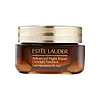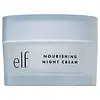What's inside
What's inside
 Key Ingredients
Key Ingredients

 Benefits
Benefits

 Concerns
Concerns

 Ingredients Side-by-side
Ingredients Side-by-side

Water
Skin ConditioningButyrospermum Parkii Butter
Skin ConditioningTheobroma Cacao Seed Butter
EmollientCoco-Caprylate/Caprate
EmollientCaprylic/Capric/Myristic/Stearic Triglyceride
EmollientButylene Glycol
HumectantGlyceryl Stearate
EmollientCetyl Alcohol
EmollientGlycerin
HumectantC9-12 Alkane
SolventDimethicone
EmollientCetearyl Alcohol
EmollientPEG-100 Stearate
Tripeptide-32
Skin ConditioningSodium Hyaluronate
HumectantSodium Polyglutamate
HumectantSuccinic Acid
BufferingArtemia Extract
Skin ConditioningSqualane
EmollientLactobacillus Ferment
Skin ConditioningTocopheryl Acetate
AntioxidantCaffeine
Skin ConditioningAlgae Extract
EmollientLavandula Angustifolia Flower Extract
CleansingHydrolyzed Rice Extract
Skin ConditioningYeast Extract
Skin ConditioningHordeum Vulgare Extract
EmollientAnthemis Nobilis Flower Extract
MaskingCucumis Sativus Fruit Extract
EmollientHelianthus Annuus Seed Extract
Skin ConditioningSorbitol
HumectantPotassium Palmitoyl Hydrolyzed Wheat Protein
CleansingPropylene Glycol Dicaprate
EmollientMaltodextrin
AbsorbentSteareth-21
CleansingDimethicone Crosspolymer-3
Skin ConditioningSteareth-2
EmulsifyingHexylene Glycol
EmulsifyingXanthan Gum
EmulsifyingCaprylyl Glycol
EmollientEthylhexylglycerin
Skin ConditioningGlucose
HumectantBHT
AntioxidantDisodium EDTA
Phenoxyethanol
PreservativeSodium Dehydroacetate
PreservativePotassium Sorbate
PreservativeCI 19140
Cosmetic ColorantCI 14700
Cosmetic ColorantWater, Butyrospermum Parkii Butter, Theobroma Cacao Seed Butter, Coco-Caprylate/Caprate, Caprylic/Capric/Myristic/Stearic Triglyceride, Butylene Glycol, Glyceryl Stearate, Cetyl Alcohol, Glycerin, C9-12 Alkane, Dimethicone, Cetearyl Alcohol, PEG-100 Stearate, Tripeptide-32, Sodium Hyaluronate, Sodium Polyglutamate, Succinic Acid, Artemia Extract, Squalane, Lactobacillus Ferment, Tocopheryl Acetate, Caffeine, Algae Extract, Lavandula Angustifolia Flower Extract, Hydrolyzed Rice Extract, Yeast Extract, Hordeum Vulgare Extract, Anthemis Nobilis Flower Extract, Cucumis Sativus Fruit Extract, Helianthus Annuus Seed Extract, Sorbitol, Potassium Palmitoyl Hydrolyzed Wheat Protein, Propylene Glycol Dicaprate, Maltodextrin, Steareth-21, Dimethicone Crosspolymer-3, Steareth-2, Hexylene Glycol, Xanthan Gum, Caprylyl Glycol, Ethylhexylglycerin, Glucose, BHT, Disodium EDTA, Phenoxyethanol, Sodium Dehydroacetate, Potassium Sorbate, CI 19140, CI 14700
Water
Skin ConditioningDimethicone
EmollientButylene Glycol
HumectantEthylhexyl Palmitate
EmollientHydrogenated Polyisobutene
EmollientButyrospermum Parkii Butter
Skin ConditioningSimmondsia Chinensis Seed Oil
EmollientGlycerin
HumectantCetearyl Olivate
Sorbitan Olivate
EmulsifyingAloe Barbadensis Leaf Extract
EmollientCucumis Sativus Fruit Extract
EmollientCetearyl Alcohol
EmollientStearic Acid
CleansingDimethiconol
EmollientXanthan Gum
EmulsifyingSodium Hyaluronate
HumectantTriethanolamine
BufferingAcrylates/C10-30 Alkyl Acrylate Crosspolymer
Emulsion StabilisingTocopheryl Acetate
AntioxidantSodium Dehydroacetate
PreservativeSaccharum Officinarum Extract
MoisturisingVaccinium Myrtillus Fruit/Leaf Extract
AstringentCitrus Sinensis Fruit Extract
AntioxidantCitrus Limon Fruit Extract
MaskingDisodium EDTA
Phenoxyethanol
PreservativeCaprylyl Glycol
EmollientWater, Dimethicone, Butylene Glycol, Ethylhexyl Palmitate, Hydrogenated Polyisobutene, Butyrospermum Parkii Butter, Simmondsia Chinensis Seed Oil, Glycerin, Cetearyl Olivate, Sorbitan Olivate, Aloe Barbadensis Leaf Extract, Cucumis Sativus Fruit Extract, Cetearyl Alcohol, Stearic Acid, Dimethiconol, Xanthan Gum, Sodium Hyaluronate, Triethanolamine, Acrylates/C10-30 Alkyl Acrylate Crosspolymer, Tocopheryl Acetate, Sodium Dehydroacetate, Saccharum Officinarum Extract, Vaccinium Myrtillus Fruit/Leaf Extract, Citrus Sinensis Fruit Extract, Citrus Limon Fruit Extract, Disodium EDTA, Phenoxyethanol, Caprylyl Glycol
Ingredients Explained
These ingredients are found in both products.
Ingredients higher up in an ingredient list are typically present in a larger amount.
Butylene Glycol (or BG) is used within cosmetic products for a few different reasons:
Overall, Butylene Glycol is a safe and well-rounded ingredient that works well with other ingredients.
Though this ingredient works well with most skin types, some people with sensitive skin may experience a reaction such as allergic rashes, closed comedones, or itchiness.
Learn more about Butylene GlycolThis ingredient is also known as shea butter. It is an effective skin hydrator and emollient.
Emollients help soothe and soften your skin. It does this by creating a protective film on your skin. This barrier helps trap moisture and keeps your skin hydrated. Emollients may be effective at treating dry or itchy skin.
Shea butter is rich in antioxidants. Antioxidants help fight free-radicals, or molecules that may harm the body. It is also full of fatty acids including stearic acid and linoleic acid. These acids help replenish the skin and keep skin moisturized.
While Shea Butter has an SPF rating of about 3-4, it is not a sunscreen replacement.
Shea butter may not be fungal acne safe. We recommend speaking with a professional if you have any concerns.
Learn more about Butyrospermum Parkii ButterCaprylyl Glycol is a humectant and emollient, meaning it attracts and preserves moisture.
It is a common ingredient in many products, especially those designed to hydrate skin. The primary benefits are retaining moisture, skin softening, and promoting a healthy skin barrier.
Though Caprylyl Glycol is an alcohol derived from fatty acids, it is not the kind that can dry out skin.
This ingredient is also used as a preservative to extend the life of products. It has slight antimicrobial properties.
Learn more about Caprylyl GlycolCetearyl alcohol is a mixture of two fatty alcohols: cetyl alcohol and stearyl alcohol. It is mainly used as an emulsifier. Emulsifiers help prevent the separation of oils and products. Due to its composition, it can also be used to thicken a product or help create foam.
Cetearyl alcohol is an emollient. Emollients help soothe and hydrate the skin by trapping moisture.
Studies show Cetearyl alcohol is non-toxic and non-irritating. The FDA allows products labeled "alcohol-free" to have fatty alcohols.
This ingredient is usually derived from plant oils such as palm, vegetable, or coconut oils. There is debate on whether this ingredient will cause acne.
Due to the fatty acid base, this ingredient may not be Malassezia folliculitis safe.
Learn more about Cetearyl AlcoholThis extract comes from cucumber. Cucumbers are mostly made up of water (95%), and the other 5% is composed of: vitamin C, caffeic acid, fatty acids, amino acids, and other minerals.
Cucumbers have anti-inflammatory, barrier repair, and hydrating properties.
They contain shikimate dehydrigenase, an enzyme shown to help reduce inflammation and soothe the skin.
The amino acids found in cucumbers help nourish our skin's natural acid mantle (it's an important part of our skin barrier). This slightly acidic film acts as a barrier to protect us from bacteria, viruses, and other contaminants.
Unless you have an allergy to cucumbers, this is generally a non-irritating ingredient.
Fun fact: Cucumis Sativus is native to South Asia and can now be found on every continent.
Learn more about Cucumis Sativus Fruit ExtractDimethicone is a type of synthetic silicone created from natural materials such as quartz.
What it does:
Dimethicone comes in different viscosities:
Depending on the viscosity, dimethicone has different properties.
Ingredients lists don't always show which type is used, so we recommend reaching out to the brand if you have questions about the viscosity.
This ingredient is unlikely to cause irritation because it does not get absorbed into skin. However, people with silicone allergies should be careful about using this ingredient.
Note: Dimethicone may contribute to pilling. This is because it is not oil or water soluble, so pilling may occur when layered with products. When mixed with heavy oils in a formula, the outcome is also quite greasy.
Learn more about DimethiconeDisodium EDTA plays a role in making products more stable by aiding other preservatives.
It is a chelating agent, meaning it neutralizes metal ions that may be found in a product.
Disodium EDTA is a salt of edetic acid and is found to be safe in cosmetic ingredients.
Learn more about Disodium EDTAGlycerin is already naturally found in your skin. It helps moisturize and protect your skin.
A study from 2016 found glycerin to be more effective as a humectant than AHAs and hyaluronic acid.
As a humectant, it helps the skin stay hydrated by pulling moisture to your skin. The low molecular weight of glycerin allows it to pull moisture into the deeper layers of your skin.
Hydrated skin improves your skin barrier; Your skin barrier helps protect against irritants and bacteria.
Glycerin has also been found to have antimicrobial and antiviral properties. Due to these properties, glycerin is often used in wound and burn treatments.
In cosmetics, glycerin is usually derived from plants such as soybean or palm. However, it can also be sourced from animals, such as tallow or animal fat.
This ingredient is organic, colorless, odorless, and non-toxic.
Glycerin is the name for this ingredient in American English. British English uses Glycerol/Glycerine.
Learn more about GlycerinPhenoxyethanol is a preservative that has germicide, antimicrobial, and aromatic properties. Studies show that phenoxyethanol can prevent microbial growth. By itself, it has a scent that is similar to that of a rose.
It's often used in formulations along with Caprylyl Glycol to preserve the shelf life of products.
This ingredient is a preservative with antimicrobial properties. It is the sodium salt of dehydroacetic acid.
It is especially effective at preventing bacterial and fungal growth in low concentrations.
Sodium Hyaluronate is hyaluronic acid's salt form. It is commonly derived from the sodium salt of hyaluronic acid.
Like hyaluronic acid, it is great at holding water and acts as a humectant. This makes it a great skin hydrating ingredient.
Sodium Hyaluronate is naturally occurring in our bodies and is mostly found in eye fluid and joints.
These are some other common types of Hyaluronic Acid:
Learn more about Sodium HyaluronateTocopheryl Acetate is AKA Vitamin E. It is an antioxidant and protects your skin from free radicals. Free radicals damage the skin by breaking down collagen.
One study found using Tocopheryl Acetate with Vitamin C decreased the number of sunburned cells.
Tocopheryl Acetate is commonly found in both skincare and dietary supplements.
Learn more about Tocopheryl AcetateWater. It's the most common cosmetic ingredient of all. You'll usually see it at the top of ingredient lists, meaning that it makes up the largest part of the product.
So why is it so popular? Water most often acts as a solvent - this means that it helps dissolve other ingredients into the formulation.
You'll also recognize water as that liquid we all need to stay alive. If you see this, drink a glass of water. Stay hydrated!
Learn more about WaterXanthan gum is used as a stabilizer and thickener within cosmetic products. It helps give products a sticky, thick feeling - preventing them from being too runny.
On the technical side of things, xanthan gum is a polysaccharide - a combination consisting of multiple sugar molecules bonded together.
Xanthan gum is a pretty common and great ingredient. It is a natural, non-toxic, non-irritating ingredient that is also commonly used in food products.
Learn more about Xanthan Gum